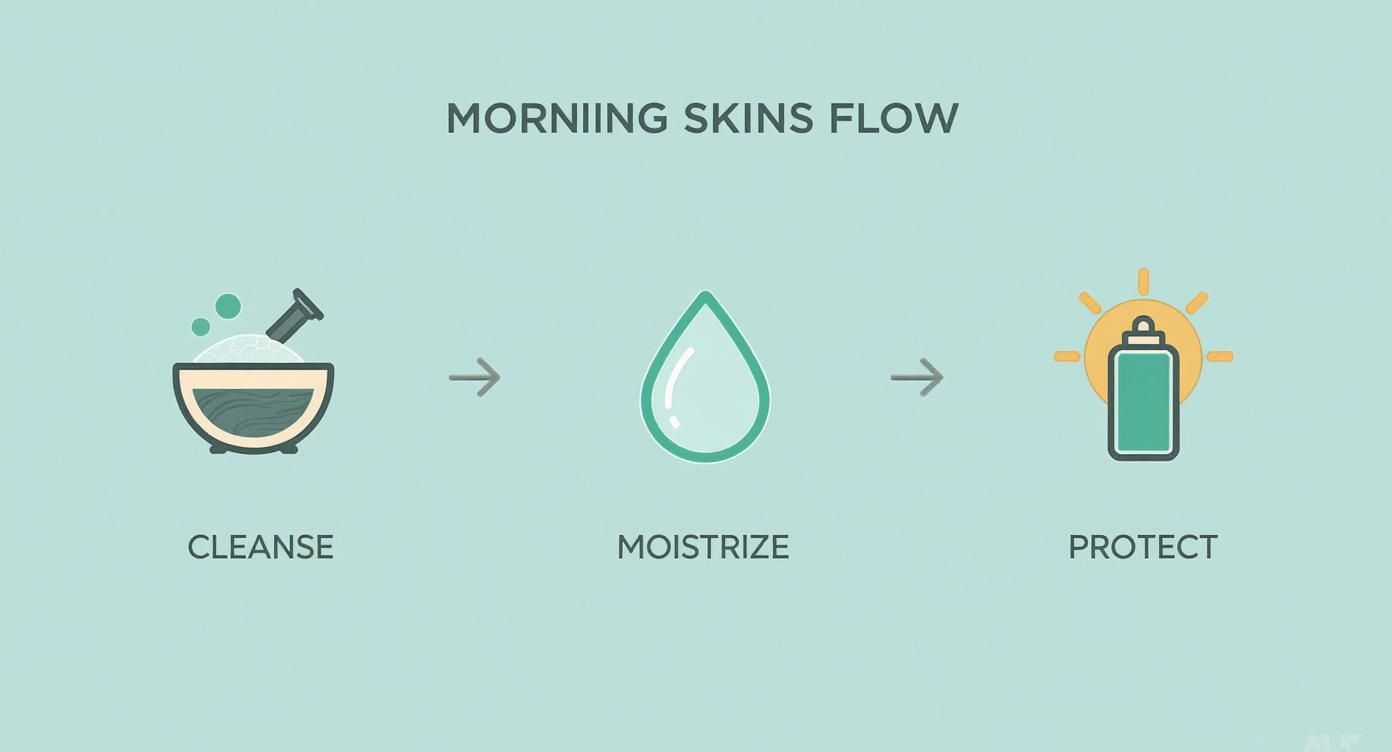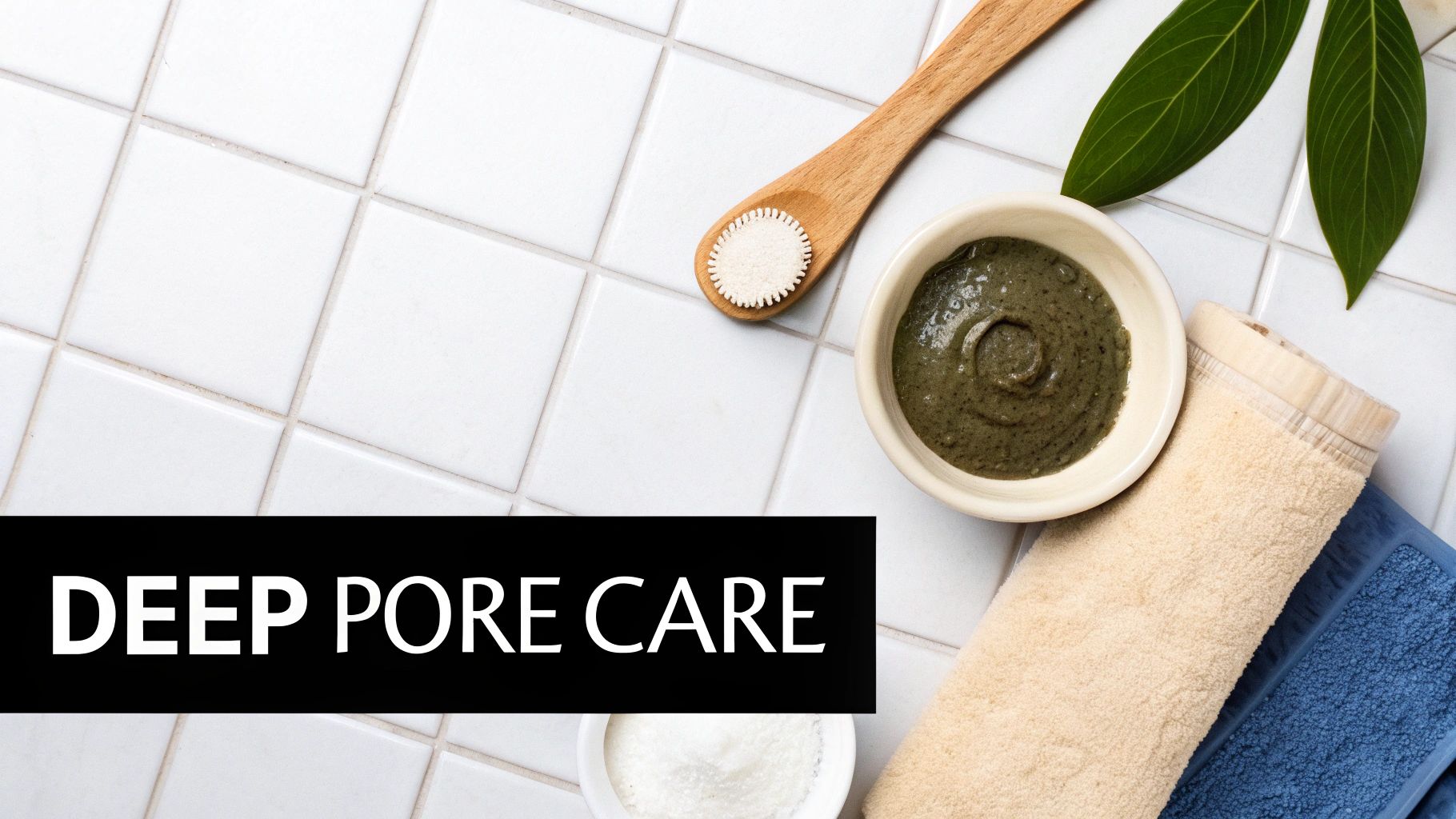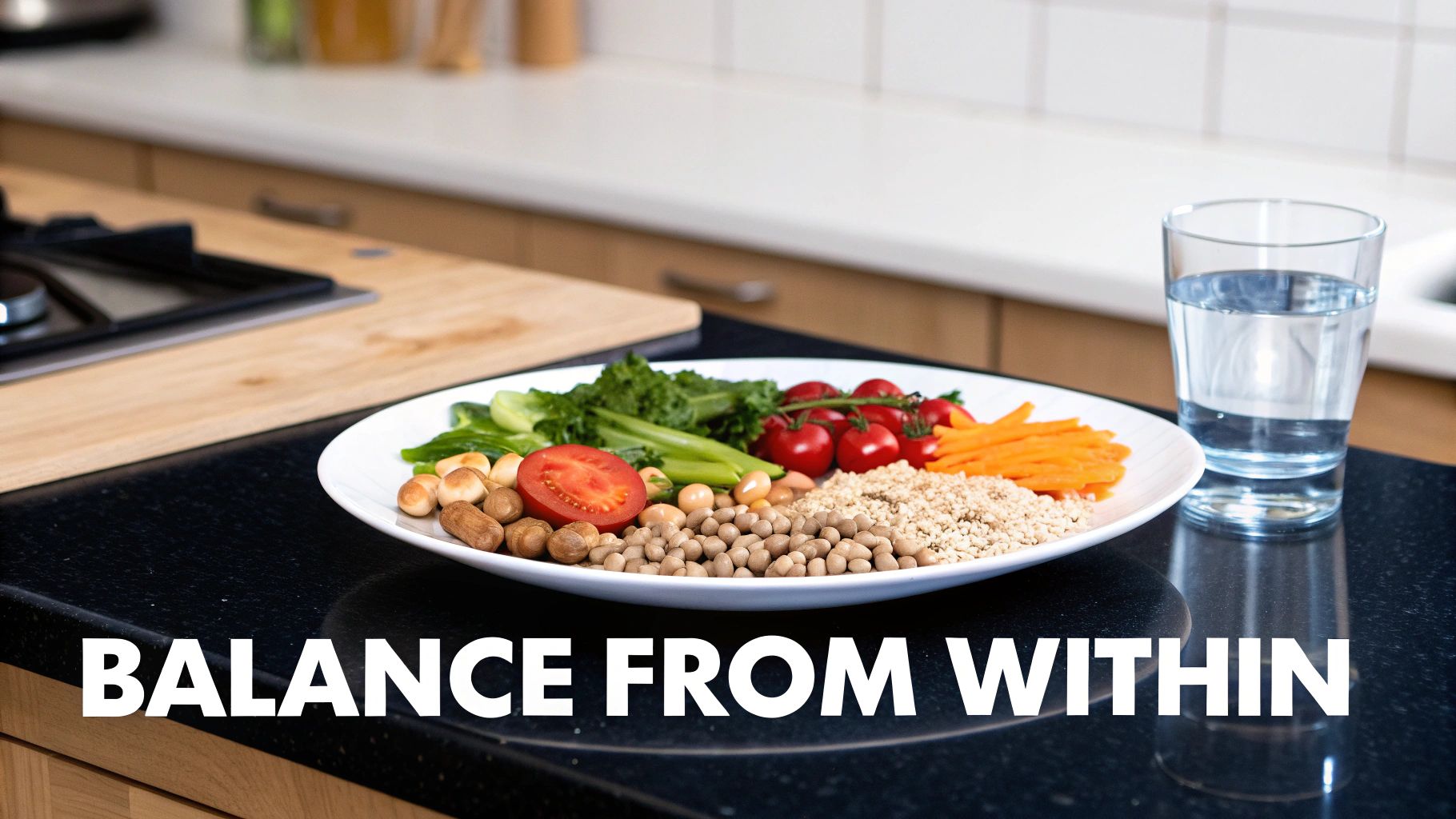Jan Elvis
04.11.2025

Jan Elvis
04.11.2025
If you're constantly battling shine, you know the struggle is real. But managing oily skin isn't about stripping it bare; it's about finding a healthy balance. The secret is to figure out what triggers the excess oil in the first place and then build a smart, consistent routine to get it under control. A simple strategy that focuses on gentle cleansing, the right kind of hydration, and a few key treatments can be all it takes to turn that greasy feeling into a natural, healthy glow.

Before you can really get a handle on oily skin, it helps to know what’s going on underneath the surface. That shine isn't just a random annoyance—it’s a direct message from your sebaceous glands, which are working overtime. These little glands produce sebum, the natural oil that’s meant to protect and moisturize your skin. When they get a little too enthusiastic, you end up with that slick feeling, noticeable pores, and a much higher chance of breakouts.
It's not just one thing that kicks your oil production into high gear. It's usually a combination of your own biology and the world around you.
More often than not, the main culprits behind excess oil are things we can’t really change. But just knowing what they are can help you build a much better game plan. For a lot of us, it just comes down to our DNA.
Beyond the things you can't control, some of our daily habits can accidentally throw our skin's balance completely out of whack, making the oiliness even worse. A classic mistake is over-washing with harsh, stripping cleansers. This strips away all the good, natural oil, which sends your skin into a panic. It then produces even more oil to compensate, trapping you in a frustrating cycle. Using heavy, pore-clogging creams or the wrong makeup can also trap oil and just makes everything feel heavier and look shinier.
Remember, the goal isn't to get rid of oil completely. Healthy skin needs some sebum to protect itself and stay hydrated. It's all about finding that happy medium.
With so many people looking for answers, it's no surprise that the demand for the right products is through the roof. The global market for oily skin solutions was valued at around USD 5 billion in 2025 and is expected to more than double by 2035. If you’re still trying to pinpoint exactly what your skin needs, our guide on how you can tell your skin type is a great place to start.
Your morning routine is all about setting your skin up for a successful, shine-free day. It’s not about piling on a ton of products; it's about a few smart moves to keep that excess oil in check without causing irritation. The biggest mistake people with oily skin make is trying to strip away every last bit of oil, but that just puts your skin into panic mode, causing it to produce even more sebum.
The real goal is balance. We want to gently cleanse, provide lightweight hydration, and protect your skin from the sun. Get these three things right, and you're well on your way to a calmer, clearer complexion.
First thing in the morning, you need to wash away the oil and impurities that have built up overnight. But put down that harsh, stripping cleanser that makes your face feel squeaky clean and tight. That’s a major red flag for irritation.
Instead, reach for a gentle gel or low-foaming cleanser. Look for one with salicylic acid—it’s a fantastic ingredient that gets down into your pores to clear them out without being overly aggressive. Remember to use lukewarm water and your fingertips, not a rough washcloth. Be gentle, then pat your skin dry.
After cleansing, a good toner can make a world of difference. It’s perfect for whisking away any lingering residue, tightening up the look of your pores, and getting your skin ready for the next steps. If you’re not sure where to start, our guide to the best skin toners has some great options specifically for oil-prone skin.
I can't say this enough: even oily skin needs a moisturizer. Skipping it is a classic mistake that actually makes things worse. When your skin gets dehydrated, its natural response is to pump out more oil to compensate. You see the problem?
The trick is to find the right kind of hydration. You want something lightweight, breathable, and non-comedogenic (a fancy way of saying it won't clog your pores). Gel and water-based formulas are your best friends here. They sink in quickly and don't leave behind a greasy film. Keep an eye out for niacinamide on the ingredient list—it's a powerhouse for regulating oil and smoothing out skin texture.
Finding the right ingredients for your morning routine can feel like a guessing game, so here's a quick cheat sheet to help you out.
| Ingredient | Primary Function | Best For |
|---|---|---|
| Salicylic Acid | Exfoliates inside pores, reduces oil | Preventing breakouts and blackheads |
| Niacinamide | Regulates sebum, minimizes pores, calms redness | Overall oil control and improving skin texture |
| Hyaluronic Acid | Provides lightweight, oil-free hydration | Keeping skin balanced without adding grease |
| Zinc Oxide | Offers sun protection with a matte finish | Sunscreens that won't feel heavy or shiny |
This table is a great starting point when you're scanning product labels. Focusing on these key players will help you build a routine that actually works.
Finally, and this is absolutely non-negotiable, you must wear sunscreen. Every single day. Oily skin is a common dermatological challenge, and sun exposure can seriously aggravate inflammation and make those pesky post-acne marks stick around longer. According to clinical research, UV rays can worsen issues for seborrheic skin, so protection is crucial. Look for a broad-spectrum sunscreen with at least SPF 30 that’s labeled "oil-free" or has a "matte finish."
Key Takeaway: A winning morning routine for oily skin is simple: a gentle cleanse to start fresh, a lightweight moisturizer to hydrate without the shine, and a solid sunscreen to protect. Consistency is everything.
When the day is done, your skin is just getting started on its most important work: repairing itself. Your evening routine is all about helping it do that job. It's your chance to clear away the day's buildup of oil, sweat, and pollution, letting your skin breathe and regenerate while you sleep.
This isn’t about scrubbing your face raw. Think of it as a strategic reset. A solid evening cleanse is the bedrock of managing oily skin. If you wear makeup or a heavy-duty sunscreen, a single pass with a cleanser often just won't cut it. That's where double cleansing becomes a total game-changer.
The idea behind double cleansing is simple but incredibly effective. First, you use an oil-based cleanser or micellar water. This initial step is designed to melt away makeup, sunscreen, and the excess sebum that’s accumulated on your skin's surface. Because oil attracts oil, this method lifts away stubborn, oil-based gunk without any harsh rubbing.
Next, you follow up with a gentle, water-based cleanser—the same gel cleanser from your morning routine works perfectly here. This second wash whisks away any leftover residue and purifies the skin itself. This one-two punch ensures your pores are truly clean and prepped for any treatments that come next.
The whole point of an evening cleanse is to create a perfectly clean slate. This not only prevents clogged pores and breakouts but also allows your skin to focus on repairing itself overnight. You'll wake up to a much more balanced, less greasy complexion.
With your skin freshly cleansed and receptive, it’s the perfect time to apply active ingredients that do their best work at night. This is your opportunity to bring in the heavy hitters that refine skin texture and keep pores clear.
The demand for effective skincare is skyrocketing. The global market, valued at USD 162.11 billion in 2025, is expected to climb to USD 222.07 billion by 2030. In the U.S., moisturizers alone make up roughly 42% of skincare revenue, which just goes to show how essential they are. If you’re interested in the numbers, you can dive into a 2025 U.S. market overview on Tricoci University.
While targeted treatments are crucial, your evening routine is just one piece of the puzzle. The infographic below outlines the simple, foundational steps for a solid morning routine.

This just reinforces that getting oily skin under control relies on consistent, smart care both day and night. When you combine a protective morning routine with a restorative evening one, you create a 24-hour cycle of balance and control.

Your daily routine is the bedrock of keeping shine under control, but adding a weekly treatment is like calling in the special forces. These more potent sessions are designed to go deeper, tackling the root causes of congestion and oil in a way your daily products just can't.
Think of it as the difference between a daily wipe-down of the kitchen counter and a full-on weekend deep clean. That extra bit of effort once or twice a week is what really prevents future breakouts and refines your skin's texture over the long haul.
There's a good reason clay masks have been a staple for oily skin forever—they really work. Acting like a powerful magnet for impurities, ingredients like kaolin and bentonite clay are pros at absorbing excess sebum and pulling out the gunk that gets lodged deep in your pores.
When you use one, it's not just about that instant matte look you get after rinsing. By consistently clearing out that pore-clogging buildup, you're getting ahead of blackheads and pimples before they even start. The trick is all in the technique.
Pro Tip: Slap on a clay mask before a big day or night out. It’s my go-to trick for minimizing the appearance of pores and creating a smooth, shine-free canvas.
Exfoliation is another non-negotiable weekly habit for anyone with oily skin. Our skin type tends to hang onto dead cells, which then mix with all that excess oil to create the perfect recipe for clogged pores and a dull complexion. Sweeping those cells away is the key to revealing the brighter, clearer skin hiding underneath.
I always recommend skipping the harsh, gritty physical scrubs that can cause irritation. Instead, reach for a chemical exfoliant. Gentle yet effective ingredients like Alpha Hydroxy Acids (AHAs) and Beta Hydroxy Acids (BHAs) work by dissolving the glue that holds dead skin cells together. If you want to get into the nitty-gritty, our complete guide explains how to exfoliate your face properly.
For those times when your skin feels especially congested and you need a serious reset, you might look into professional options. In-office HydraFacial treatments can offer a level of deep cleansing and extraction that’s tough to replicate at home, giving your weekly routine a serious boost.

While your skincare products are your first line of defense against shine, what’s happening on the inside has a massive impact on your skin's behavior. A few simple adjustments to your diet and daily habits can help regulate oil production from the inside out. Think of it as creating a more balanced internal environment, which makes everything you do on the surface that much more effective.
The link between what you eat and how your skin looks is undeniable. High-glycemic foods, in particular, can send your blood sugar on a rollercoaster. That spike often triggers a hormonal response that ramps up sebum production—the very thing we’re trying to get under control.
You don’t have to completely overhaul your diet overnight. Small, mindful swaps can make a surprisingly big difference over time. It's all about choosing foods that help calm your system rather than send it into overdrive.
Start by paying attention to sugary snacks, white bread, and other processed foods. Trading these for lower-glycemic options helps keep your blood sugar stable, which in turn, helps your oil glands chill out.
Keeping your internal environment balanced is key. There's a critical link between gut health and skin, and focusing on probiotics can lead to some pretty significant improvements. When your gut is happy, it often shows on your skin.
Stress and a lack of sleep are two other major culprits behind overactive oil glands. When you’re stressed, your body pumps out more cortisol, a hormone that can basically tell your sebaceous glands to work overtime. Likewise, not getting enough quality shut-eye messes with your body's natural repair cycles and hormonal balance.
Key Insight: Start thinking of stress management and sleep as non-negotiable skincare steps. They directly influence the hormones that control oil production, making them just as important as your cleanser or moisturizer.
To get a handle on stress, you have to find what works for you. Maybe it's a quick 10-minute meditation session in the morning, a consistent workout routine, or just taking short breaks to walk and breathe during a hectic day. These practices aren't just for your mind; your skin will thank you, too.
For better sleep, consistency is your best friend. Try to go to bed and wake up around the same time each day, even on weekends. Creating a relaxing wind-down routine—like reading a book or putting your phone away an hour before bed—signals to your body that it's time to rest and repair. By tackling diet, stress, and sleep, you’re hitting oily skin from every angle for results that actually last.
When you have oily skin, figuring out the right skincare can feel like you're navigating a minefield of bad advice. It's easy to get lost in all the myths and "quick fixes" out there. That's why we're cutting through the confusion to tackle some of the most common questions we hear.
Let’s get you the clear, straightforward answers you need to build a routine that actually makes a difference.
This is the big one, and the answer is a huge, unequivocal yes. I know it sounds completely backward—why add moisture to skin that already feels greasy? But skipping moisturizer is one of the biggest mistakes you can make.
When your skin gets dehydrated (which can happen even to oily skin!), it triggers a panic response. Your glands go into overdrive, pumping out even more oil to try and compensate. The right moisturizer breaks that cycle.
Your mission is to find a formula that hydrates without adding extra oil or clogging your pores.
A hydrated skin barrier is a balanced skin barrier. Think of moisturizer as your way of telling your skin, "It's all good, you can calm down with the oil production now."
Exfoliation is non-negotiable for oily skin. It’s your secret weapon for clearing away the dead skin cells that love to mix with oil and clog your pores. But—and this is a big but—it's incredibly easy to overdo it.
Scrubbing too often can strip your skin’s natural protective barrier. This leads to irritation, redness, and, you guessed it, a major rebound in oil production as your skin tries to defend itself.
For most people with oily skin, two to three times a week is the sweet spot. I always recommend a gentle chemical exfoliant, like one with salicylic acid (a BHA), instead of a harsh, gritty scrub. Listen to your skin; if you see any extra redness or feel any sensitivity, that's your cue to pull back.
It's true that for a lot of people, oil production naturally slows down as they get older. Hormonal changes, especially later in life, often mean skin becomes drier. So, there's a good chance your skin will become less of an oil slick as time goes on.
However, genetics are a massive factor here. Some of us are just wired to have oilier skin for the long haul. Instead of just waiting and hoping to outgrow it, your best bet is to focus on managing it well right now. A smart, consistent routine will keep your skin looking clear and feeling balanced, no matter your age.
Blotting papers are a lifesaver—definitely a good idea. For a quick shine fix during the day, they are so much better than piling on more and more powder. That can just lead to a cakey look and, even worse, clogged pores.
They work by soaking up excess oil right from the surface without messing up your makeup. The key is in the technique: press, don't rub. Gently press a sheet onto your T-zone (forehead, nose, and chin) or wherever you see shine. If you rub, you’re just smearing oil and bacteria around, which kind of defeats the whole purpose.
Once you have the right information, managing oily skin feels a lot less like a constant battle. Building a simple, effective routine with products that get the job done is the first step toward feeling confident in your skin.
At Main Character, we make straightforward personal care products to help you look and feel your best, without the hassle. Find your new go-to routine at dontlooktrash.com.